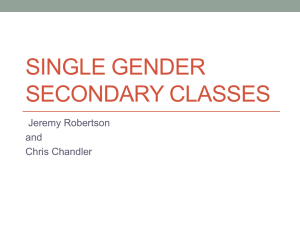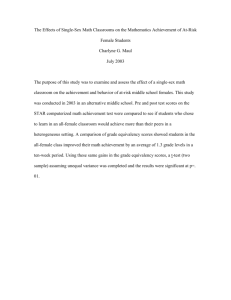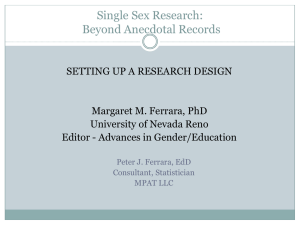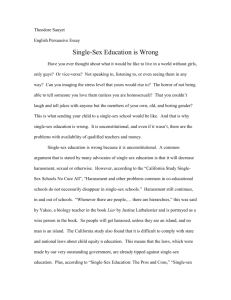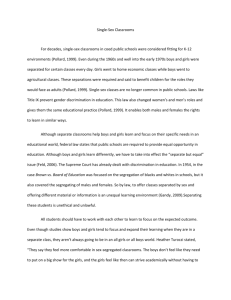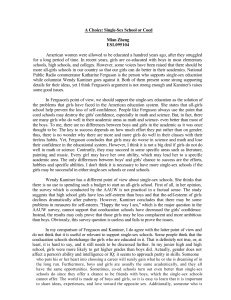Alsubaie Othman Alsubaie Ms. McIntosh ENG 105 – 8:30 28
advertisement
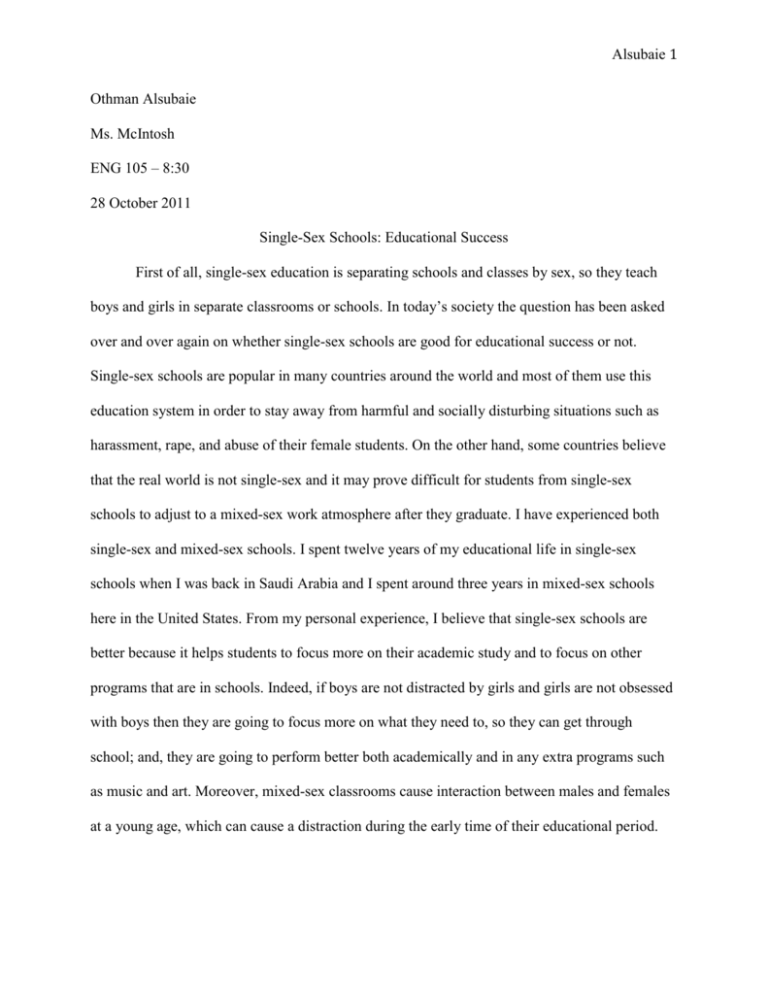
Alsubaie 1 Othman Alsubaie Ms. McIntosh ENG 105 – 8:30 28 October 2011 Single-Sex Schools: Educational Success First of all, single-sex education is separating schools and classes by sex, so they teach boys and girls in separate classrooms or schools. In today’s society the question has been asked over and over again on whether single-sex schools are good for educational success or not. Single-sex schools are popular in many countries around the world and most of them use this education system in order to stay away from harmful and socially disturbing situations such as harassment, rape, and abuse of their female students. On the other hand, some countries believe that the real world is not single-sex and it may prove difficult for students from single-sex schools to adjust to a mixed-sex work atmosphere after they graduate. I have experienced both single-sex and mixed-sex schools. I spent twelve years of my educational life in single-sex schools when I was back in Saudi Arabia and I spent around three years in mixed-sex schools here in the United States. From my personal experience, I believe that single-sex schools are better because it helps students to focus more on their academic study and to focus on other programs that are in schools. Indeed, if boys are not distracted by girls and girls are not obsessed with boys then they are going to focus more on what they need to, so they can get through school; and, they are going to perform better both academically and in any extra programs such as music and art. Moreover, mixed-sex classrooms cause interaction between males and females at a young age, which can cause a distraction during the early time of their educational period. Alsubaie 2 Single-sex schools will help students to improve their grades, raise their self-esteem, and reduce the number of teenage pregnancy. Single-sex education will help students to improve their grades. Students find it easier to focus on academics when they are not distracted by members of the opposite sex. In the British Journal of Sociology of Education, author Richard Harker states, “Single-sex schools (for both boys and girls) are held in greater esteem by the community and are generally thought to achieve better academic results for their students in public examinations” (Harker). Research has repeatedly shown that there is a big difference between boys' and girls' brains, and therefore requires different teaching styles to maximize education. The group of the National Association for Single Sex Public Education states that “Girls in single-sex environments are more likely to demonstrate an interest in math, science and computers, while boys are more likely to show an interest in foreign languages, music, art and drama” (qtd. in “Update: Single-Sex Education”). In contrast, some believe that single-sex schools do not prepare students for real life. It's certain that males and females will have to work with each other at some point during their careers. The benefits of single-sex classrooms are not limited to improve the students’ achievements. A number of studies have shown that students who graduated from single-sex schools have more self-confidence and have a more serious approach to academics. The Director of Education for The Young Women’s Leadership Foundation, Kathleen Ponze, says, “the benefits of attending an all girls school include ample opportunities for leadership development, strong academics, individual attention, and a focus on healthy female adolescent development” (qtd. in Wood). The discipline differences between the two genders are quite obvious, starting at an early age when parents allow boys to play rough but tell girls to act like girls. In addition, Alsubaie 3 single-sex schools eliminate gender unfairness and are shown to give students both academic and personal benefits. Teenage pregnancy is big a issue in the United States, since it has one of the highest rate of teen birth in the world. Single-sex schools will help reduce the number of teenage pregnancies. Girls in mixed-sex schools are more likely to get pregnant at an early age. In addition, the mixed-sex schools’ atmosphere puts girls under pressure to have sex at earlier ages. If all the other girls in their group are having sex with their boyfriends, that puts more pressure on a girl to conform and engage in it too. Girls would be less pressured to engage in teenage sex if they were in single-sex schools. I think single-sex schools force students to keep their dating relationships separate from their friendships at school. Since there would be less exposure to the opposite sex on a daily basis, this would decrease the number of teenage pregnancies. In brief, I believe there can be no question anymore: research over the last decades prove that single-sex education is valid and a better option. According to the textbook Current Issues and Enduring Questions, Sally Reed says, “Single-sex schools for females provide a greater opportunity for educational attainment as measured by standardized tests, curriculum and course placement, leadership behavior, number of years formal education, and occupational achievement” (Reed 542). Single-sex schools offer more than just academic advantages; they also offer personal benefits for the students. Moreover, single-sex classes remove gender bias and unequal treatment that exist in mixed-sex schools. In addition, students who attend singlesex schools are much more likely to hold leadership positions in their profession, compared with students of comparable ability who attend mixed-sex schools. Nevertheless, the only disadvantage of single-sex schools appears to be the lack of socialization. Students who studied in single sex schools may face difficulties when they deal with the opposite sex in their career Alsubaie 4 life. Some believe that students need to learn how to deal with the opposite sex at an early age. I believe that single-sex schools offer unique educational opportunities for both boys and girls. Research has repeatedly shown that boys and girls perform better in single-sex schools. Singlesex education helps students participate more in class, develop higher self-esteem, score higher in aptitude tests, reduce the number of teenage pregnancies, and it helps students to be more successful in their future careers. Alsubaie 5 Works Cited Harker, Richard. “Achievement, Gender and the Single-Sex/Coed Debate.” British Journal of Sociology of Education 21.2 (2000): 203-18. Web. 31 Oct. 2011. Reed, Sally. “Girls and Boys Thrive in Separate Classrooms.” Current Issues and Enduring Questions. Eds. Sylvan Barnet and Hugo Bedau. 9th ed. Boston: Bedford/St. Martin’s, 2011. 541-543. Print. “Update: Single-Sex Education.” Issues & Controversies On File: n. pag. Issues & Controversies. Facts On File News Services, 6 June 2008. Web. 30 Oct. 2011. <http://www.2facts.com.ezproxy.waterfield.murraystate.edu/article/i1300310>. Wood, Danielle. “Single Sex Education: The New Segregation?” Education.com. Education.com, Inc., 28 Mar. 2008. Web. 31 Oct. 2011. <http://www.education.com/magazine/article/Single_Sex_Education_The_New/>.
